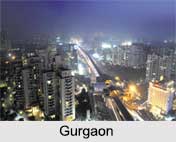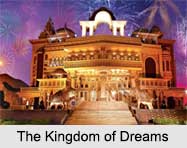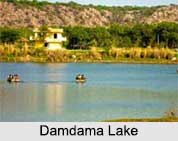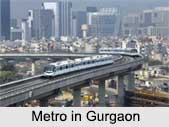 Gurgaon is a city in the Indian state of Haryana. It has become a foremost monetary and manufacturing centre with the third-highest per capita profits in India. Gurgaon had been a centre of learning and Haryana is a historic land of the "Bhagwat Gita". Gurgaon is also known as Gurugram.
Gurgaon is a city in the Indian state of Haryana. It has become a foremost monetary and manufacturing centre with the third-highest per capita profits in India. Gurgaon had been a centre of learning and Haryana is a historic land of the "Bhagwat Gita". Gurgaon is also known as Gurugram.
Location of Gurgaon
Gurgaon is situated at 32 kilometres southwest of New Delhi and 268 kilometres south of Chandigarh. It is a city of the Indian state of Haryana. It is a part of the National Capital Region of India.
Etymology of Gurgaon
Gurgaon came to be known as Gurugram and over time it became Gurgaon. Chief Minister of Haryana Manohar Lal Khattar proclaimed a proposal formally to rename the city "Gurugram" on 12th April 2016. On 27th September 2016, Manohar Lal Khattar officially announced that the Union Government had agreed the name change, and thus the city and district would hereafter be recognized as Gurugram. Gurgaon has still remained in general everyday usage all over the city.
Climate of Gurgaon
Gurgaon receives a monsoon influenced damp subtropical type of weather. Summers here are naturally hot and humid, with a standard daily June high temperature of 40 degree Celsius. Winters are cold and cloudy with few sunny days.
History of Gurgaon
Gurgaon was historically occupied by the Hindu people. In earlier history it is told that it was the village of "Guru Dronacharya" who was the teacher of Kauravas and Pandavas. During the reign of Akbar, Gurugram was within the leading regions of Delhi and Agra. As the Mughal Empire started to demur, Gurgaon was torn between opposing powers. By 1803 most of it came under the British rule through the agreement of Surji Arjungaon with Sindhia. The town was first occupied by the army of Begum Samru of Sirdhana.
After the Revolt of 1857, it was shifted from the North-Western Provinces to Punjab Province. In 1861 the contemporary city came under the rule of Gurgaon tehsil. In 1947, Gurgaon became a part of independent India and fell under the Indian state of Punjab. In 1966, the city came under the supervision of Haryana with the creation of a new state.
Economy of Gurgaon
Gurgaon has the third-highest revenue per-capita in India. In 1970, Maruti Suzuki Private Limited was the first company that set up a built-up thing in the city. In time, DLF Limited obtained huge stretches of land in the city. Apart from Business development and information technology sectors, the city is the residence to numerous other companies that focus in domain proficiency. Siemens Industry Software, Coca-Cola, Pepsi, BMW, Agilent Technologies, Hyundai, Real estate are the prominent companies working here.
Culture of Gurgaon
The major language spoken in Gurgaon is Hindi. Haryanvi and Punjabi are other popular languages spoken in the city. The other local languages include Mewati and Haryanvi. Hinduism is a major religion among the people. Gurgaon also contains believers of Sikhism, Islam, Buddhism, Jainism, Christianity and the Bahai, in the middle of others. There are a number of places of worship for main beliefs in Gurgaon, including mandirs, gurdwaras, mosques and churches.
Education of Gurgaon
Gurgaon public school arrangement is managed by the government of Haryana. It also has a large number of private schools like Heritage Xperiential Learning School, The Shri Ram School, Ardee World School, DAV Public School, Amity International School etc. Universities and institutes of Gurgaon including Ansal Institute of Technology, ITM University, KR Mangalam University, Amity University, Apeejay Stya University, BML Munjal University, Shree Guru Gobind Singh Tricentenary University, National Brain Research Centre etc.
Popular Places of Gurgaon
 There are end numbers of tourist destinations in Gurgaon. The Kingdom of Dreams is India`s first live entertainment, relaxation and theatre destination. It presents an experience of modern and fresh India with the mix of a technological masterpiece. Cyber Hub is mainly a food cum entertainment region. Damdama Lake is an ideal location for nature lovers. It also presents a variety of activities like hot air ballooning, parasailing, kayaking, rock climbing and angling. Sohna is famous for its hot springs and Shiva Temple. Murthal is known for its "Parathas". Sultanpur Bird Sanctuary is a home to about 250 species of local birds and over 190 travelling species. Mata Sheetala Devi Mandir is also a famous spot.
There are end numbers of tourist destinations in Gurgaon. The Kingdom of Dreams is India`s first live entertainment, relaxation and theatre destination. It presents an experience of modern and fresh India with the mix of a technological masterpiece. Cyber Hub is mainly a food cum entertainment region. Damdama Lake is an ideal location for nature lovers. It also presents a variety of activities like hot air ballooning, parasailing, kayaking, rock climbing and angling. Sohna is famous for its hot springs and Shiva Temple. Murthal is known for its "Parathas". Sultanpur Bird Sanctuary is a home to about 250 species of local birds and over 190 travelling species. Mata Sheetala Devi Mandir is also a famous spot.
Visiting Information of Gurgaon
National Highway 8 that runs from Delhi to Mumbai connects Gurgaon. Gurgaon railway station is operated by Northern Railway of Indian Railways. There are five stations in Gurgaon that are served by Delhi Metro. Gurgaon is served by Delhi`s Indira Gandhi International Airport, which is situated just outside of Gurgaon city near National Highway 8.



















